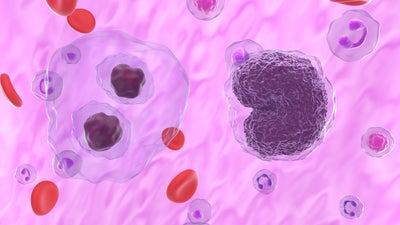Blood cancers and blood disorders: diagnostic tests
Overview of tests used to diagnose disorders and cancers
If you have a blood cancer or a blood disorder, your doctor can often get some idea of what is wrong from a blood test. But to get a full diagnosis, you will probably need other tests.
X-ray
Most people are familiar with X-rays and may have had one themselves. X-rays are a type of high-energy radiation that passes painlessly through the body. Radiographers use a very small dose of X-ray radiation to produce an image of the inside of your body.
X-rays are very safe. Depending on the X-rays you are having taken, the radiation dose is the same as a few days' worth of the natural background radiation that we are all exposed to every day (1).
X-rays do not show soft tissues very well. But bones show up clearly because it is harder for X-rays to pass through them. You may have X-rays if you have bone pain, to rule out or diagnose a fracture, which can happen with myeloma.
Having your X-ray
You do not usually need to do anything special to prepare for having an X-ray. Try to avoid having any metal in your clothing, such as zips, buckles or buttons. You have to remove these or they will show up in the X-ray image.
CT scan
CT stands for computerised tomography. These used to be called CAT scans - computerised axial tomography. A CT scanner takes a series of cross-sectional X-rays horizontally through your body- think of them as slices. A computer links the cross-sections together to give a more detailed image than a plain X-ray can.
As you have a series of X-rays taken, a CT scan exposes you to more radiation than a single X-ray. The dose is the same as a few months to a few years' worth of background radiation, depending on how much of your body you are having scanned (2).
CT scans show soft tissues more clearly than a plain X-ray. They are often used to diagnose, but can also be used to monitor conditions or see how treatment is working.
Having your scan
A CT scanner is shaped like a doughnut standing on end. You lie on a bed that slides in and out of the doughnut as the scan is taken. As with an X-ray, it is completely painless.
You do not usually need to do anything special to prepare for a CT scan, but if you do, your hospital will let you know beforehand. Try to avoid wearing clothing with metal zips, buckles or buttons as you will have to remove these for the scan. For some CT scans, you have an injection, called ‘contrast’, beforehand, which helps tissues to show up. The scan usually takes less than half an hour in total (3).
PET scan
PET stands for positron emission tomography. A positron is a nuclear (subatomic) particle. It is like an electron, but positively charged.
Unlike other types of scan, which show structure, PET scans show activity in body tissues. You have an injection beforehand, called a radionuclide. This is made of radioactive atoms attached to molecules of a substance that the body uses. These molecules collect in body tissues and the radioactive part shows up on the scan.
The choice of molecule depends on what your doctor wants to look at. For example, PET scans are often done with radioactive atoms attached to glucose molecules to form fluorodeoxyglucose (FDG): an FDG-PET scan. The more glucose a body tissue uses, the more active it is. So this type of scan can show whether a tissue is active cancer or scar tissue for example (4,5). Other types of molecules can be used to look at blood flow (4).
Having your scan
You should not exercise vigorously in the 24 hours before your scan. You usually cannot eat for up to six hours beforehand: your hospital will tell you exactly what to do. Once again, avoid metal in your clothing as it interferes with the scan (5).
On the day of your scan, you must arrive on time. The radionuclide injections decay very quickly, so if you are late, you may not be able to have the scan (5).
Your radiographer may ask you to change into a gown. You have the radionuclide injection into a vein in your hand or arm. Then you rest quietly for around an hour, while it moves around your body and collects in the tissues your doctor wants to look at. You have to stay still and quiet as moving and speaking can affect where the radionuclide goes. To have the scan, you lie on a bed that moves into the scanner, which is a cylinder. It usually takes between half an hour to an hour (5).
The amount of radiation used is very small, so PET scans are very safe. It takes a while for it to pass out of your body. So do not be concerned if you are advised to stay away from pregnant women, babies and very young children for a few hours afterwards. Drinking plenty of fluids can help to flush it out (6).
PET-CT scans
A CT scan combined with a PET scan can show structure and activity in body tissues.
A PET-CT scan will use more radiation than either scan on its own. But your doctor will only ask you to have one if the benefits outweigh any risk and it is more important to be properly diagnosed and treated. For a whole-body scan, the radiation dose is around the same as between two and eight years of natural background radiation (7,8)
Having your scan
The preparation and process of having a PET-CT scan is the same as for a PET scan.
MRI scan
Unlike CT and PET scans, MRI scans use magnetism, not radiation to produce images. The way they work is very complicated.
MRI scanners use the fact that the protons inside hydrogen atoms are sensitive to magnetism – they line up in one direction. During an MRI, after the protons are lined up, bursts of radio waves disrupt their position and when that is switched off, the protons line up again. As they line up, they give out signals, which the scanner picks up. Different types of body tissues give out different signals and take different lengths of time to line up again. The scanner puts these signals together to form pictures of the inside of the body (9).
To be able to have an MRI you mustn’t have any metal on you – or in you. Some people cannot have MRI scans because they have a metal implant, such as a pacemaker. Some types of implants are fine because they are not magnetic, but you must tell your doctor so they can make sure. You should also tell them if there is any possibility that you have metal fragments in your body, from metalworking for example. You can have an X-ray to make sure (10,11).
Having your scan
You can usually eat and drink normally before an MRI scan. You will be asked to fill out a questionnaire, just to make doubly sure that it is safe for you to have the scan. You may need to change into a gown. Make sure you have no metal on your body. You will have to remove hearing aids and false teeth as they can contain metal (12).
MRI scans are completely painless, but some people find them difficult because they are noisy and can feel closed in. If you are claustrophobic, tell the doctor when the scan is booked. You can have a sedative beforehand; if you do, you will need someone to take you home afterwards (12).
For some types of MRI, you have a ‘contrast’ injection that helps tissues to show up, but this is not always needed. As with the other types of scan, you lie on a bed that moves into the scanner which is like a long tube. Because of the noise, you will have earplugs or headphones to wear. An MRI can take between 15 and 90 minutes, depending on the area being scanned (12).
Ultrasound
This type of scan uses high-frequency sound waves. They bounce off different body structures and are picked up by the ultrasound probe. The returned sound waves are used to build up a moving image. Ultrasounds can be used to look at body organs, muscles and joints (13).
Having your scan
There often is not any preparation for an ultrasound. If there is anything you need to do, your hospital will let you know. For some ultrasounds, you have an injection (called ‘contrast’) that helps tissues to show up, but this is not usually necessary (13).
To have the scan, you have a cold gel put on the part of your body to be scanned. This helps to keep the ultrasound probe in contact with the skin. The radiographer then passes the probe back and forth over the area. The image will show up on a monitor straight away. Ultrasounds are completely painless and take between 15 and 45 minutes (13).
Lymph node biopsy
This means removing all or part of a lymph node (lymph gland) and looking at it under a microscope for signs of abnormal cells. So, it means having a small operation (14).
Having your biopsy
Depending on where in the body it is, you may have a lymph node biopsy under a local or general anaesthetic. The doctor will make a small cut in the skin, remove a lymph node and sew up the cut. The whole thing takes less than half an hour (14).
You will have a small dressing over the operation site. Your nurse will tell you how to look after it and whether you will need to come back to have the stitches taken out; you may have stitches that dissolve by themselves). The area may be a bit sore and bruised, but this won’t last long and you can take over-the-counter painkillers if you need to (14).
It usually takes up to two weeks to get the results of a lymph node biopsy (14).
Bone marrow biopsy
This means taking a sample of bone marrow and looking at it under a microscope for signs of abnormal cells. You have this done under a local anaesthetic; children may have a general anaesthetic.
Having your bone marrow biopsy
The bone marrow sample is usually taken from your hip. Your doctor will ask you to lie on your side, with your knees drawn up. You have an injection of local anaesthetic, you may also have a sedative to make you drowsy while the biopsy is taken. Some people prefer this because they find the biopsy quite painful, however not everyone does; it is quite individual (14).
When the area is numb, the doctor will put a long needle into the hip bone and draw out some liquid bone marrow. This is sometimes called bone marrow aspiration. They may also use a trephine, an instrument like a very, very thin apple corer, to take out a piece of bone and more some solid marrow. You will have a dressing put over the area. The whole thing usually takes less than half an hour (15).
If you are having this test as an outpatient, you can usually go home as soon as you feel able. If you have had a sedative, you will need someone to take you home (15).
Your hip will feel sore and bruised for a few days after your biopsy. You can take painkillers if you need to. It may take up to two weeks before you get the results of the biopsy (15).
Gene testing
For some types of blood cancer and blood disorders, your doctor will want to do some gene testing on the abnormal blood cells. This can help them with the diagnosis. With some conditions, the results may also give your doctor information about how the condition is likely to develop and how best to treat it (16).
Having gene tests
This is not as dramatic as it may sound. For blood cancers and blood disorders, the doctor will either use a blood sample or a bone marrow sample. You may need to have a bone marrow biopsy.
Depending on the type of gene testing carried out, it may take anything from a few days to a few weeks to get the results (16).
References
1. X-rays. Are X-rays safe? NHS website. Last reviewed July 2018.
2. CT scan. Are CT scans safe? NHS website. Last reviewed June 2018.
3. CT scan. NHS website. Last reviewed June 2018.
4. Positron Emission Tomography (PET). Johns Hopkins Medicine. Accessed July 2021.
5. PET scan. NHS website. Last reviewed March 2021.
6. PET scan. Are PET scans safe? NHS website. Last reviewed March 2021.
7. Recommendations for cross-sectional imaging in cancer management (2nd edition). Radiation dose. Royal College of Radiologists. Published February 2014.
8. Understanding radiation risk from imaging tests. American Cancer Society. Last updated August 2018.
9. MRI scan. Overview. NHS website. Last reviewed August 2018.
10. Yong-Ha, K, Manki C and Jae-Won K. Are titanium implants actually safe for magnetic resonance imaging examinations? Concerns about MRI in patients with titanium implants. Archives of Plastic Surgery, 46(1), pp96-7. Published January 2019.
11. MRI scan. Who can have one? NHS website. Last reviewed August 2018.
12. MRI scan. How it is performed. NHS website. Last reviewed August 2018.
13. Ultrasound scan. NHS website. Last reviewed August 2018.
14. Blood cancer tests. Lymph node biopsy. Blood Cancer UK. Accessed July 2021.
15. Blood cancer tests. Bone marrow biopsy. Blood Cancer UK. Accessed July 2021.
16. FISH test. WebMD. Last reviewed October 2019.


